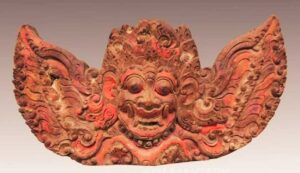Who is Kirtimukha, why is he worshipped more than gods despite being a demon, know the whole story
Kirtimukha: Can you picture a demon taking charge of guarding your temple or house? You must have seen the idol or image of this monster, even if it seems strange. But you may not know its name or its splendor. The Ganas, or manifestations, of the gods who often guard temples act as gatekeepers, such as Ramdoot Hanuman, Garuda Bhagwan, and Bhairav Maharaj. But now, we’re talking about Kirtimukha, a special kind of monster.

What makes Kirtimukha unique, and who is he?
A demon known as Kirtimukha is revered as a deity. If placed correctly, it protects the temples and the home. To keep evil spirits out of their homes, they place an idol or portrait of Kirtimukha on the walls or the main gate.
The genesis tale of Kirtimukha in mythology
At one point Lord Shiva was deeply meditating. The moon perched on Shiva’s head was then obscured by Rahu, who was ecstatic with his abilities. Shiva saw this and grew angry. He broke Rahu’s conceit by opening his third eye and conjuring Kirtimukha from his own particle out of rage.
Kirtimukha was told to consume Rahu by Shiva. This command alarmed Rahu, who then kneeled at Shiva’s feet and began pleading for pardon. Rahu was pardoned by Shiva. “Prabhu, how will my hunger be satisfied now?” Kirtimukha then questioned Shiva.
As he meditated, Shiva said, “You eat yourself.” Kirtimukha began to devour his body upon hearing this. Shiva discovered that Kirtimukha had consumed his whole body, leaving just his face and hands when he stopped his meditation.
Shiva’s favor and Kirtimukha’s splendor
Shiva said, “I am pleased with you,” upon seeing this. Your location will be outside every home and temple as of right now. All of the bad energy, hate, and rage there will be consumed by you. Following this blessing, Kirtimukha began to be revered as a god.
The torsoless horror head of Kirtimukha is displayed in the sanctum sanctorum or main entrance of Indian temples. This head is seen as a fortunate symbol in addition to serving as a guardian.
Another tale: Kirtimukha and Yogi
Some people believe that there was a yogi who used his yogic abilities to gain several powers. However, he began disparaging Lord Shiva because he was arrogant about his abilities. After becoming enraged, Lord Shiva created a demon and gave him the command to devour the yogi.
The yogi kneeled at Lord Shiva’s feet and begged for pardon. Although Lord Shiva pardoned him, he later appointed Kirtimukha as the guardian of temples and homes.
Characteristics and Views of Kirti Mukha
- Unique Face Image: Kirti Mukha’s intimidating face is shown by his huge eyes, big fangs, and frightening skull.
- Symbol of Protection: The home and temple are shielded from bad spirits and the evil eye by Kirti Mukha.
- Spiritual Significance: Kirti Mukha serves as both a defender and a warning about the negative effects of conceit and haughtiness.
Today’s Belief in Kirti Mukha
Kirti Mukha is regarded as an auspicious emblem in Indian culture. It is placed outside of temples or homes’ main entrances. Evil powers are said to be unable to enter areas with Kirti Mukha.
In conclusion
According to the Kirti Mukha tale, this self-eating demon of Lord Shiva represents the destruction of hubris as well as the fact that all living things have a purpose. Even now, this legendary figure is still deeply ingrained in our faith and culture.
Frequently Asked Questions, or FAQs:
Kirti Mukha is who?
Lord Shiva created the fabled monster Kirtimukha to undermine Rahu’s pride.
For what reason is Kirtimukha revered?
It drives out bad energy and protects houses and temples.
What does Kirtimukha look like?
The majority of its body is gone, but it possesses a big, frightening head and keen fangs.
Kirtimukha is placed where?
It is erected on the temple’s walls or at the main entrance.
What can we infer from Kirtimukha’s story?
This tale illustrates the value of self-control and the devastation of pride and ego.

